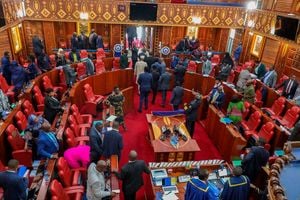
Kenyan currency notes.
| File | Nation Media GroupBusiness
Premium
Kenya Kwanza to get Sh1.8 trillion loan from World Bank
What you need to know:
- As part of the package, the International Finance Corporation (IFC) on its part has provided an investment portfolio of $1.2 billion (Sh152 billion).
- Announcement came barely two weeks after President Ruto said the lender and IMF are key partners in helping implement his economic transformation programme.
The World Bank Group has revealed a new $12 billion (Sh1.8 trillion) loan package for Kenya expected to be disbursed over the next three years beginning July 2024, in what it says will support the journey to become an “upper-middle-income country by 2030”.
The Bank, which is now Kenya’s single largest lender, has mobilised the funds through its sister funding agencies as loans and equity investments into Kenyan firms, in a major relief to the country that is facing a dollar crisis.
The lender revealed that Kenya is already accessing about $2 billion (Sh304 billion under prevailing exchange rates of $1 to Sh152) in concessional financing every year that will be topped up with fresh commitments through its other lending arms of $8.3 billion (Sh1.2 trillion), with $4.4 billion (Sh670 billion) already available for disbursement.
As part of the package, the International Finance Corporation (IFC) on its part has provided an investment portfolio of $1.2 billion (Sh152 billion).
The remaining $424 million will be provided as guarantees covering the energy, transport, financial, fintech, and tourism sectors by the Multilateral Investment Guarantee Agency (MIGA).
“So, subject to the World Bank executive directors approval of new operations, and to factors which may affect the Bank’s lending capacity, this implies a total financial package of $12 billion over the three years,” the Bank said in a statement released in Nairobi on Monday.
The lender says $4.5 billion (Sh684 billion) of the planned loans will be injected into public sector projects, $1 billion (Sh152 billion) in private firms and another $500 million (Sh76 billion) in cushioning investors against political and non-commercial risks.
The announcement came barely two weeks after President William Ruto said the lender and its sister Bretton Woods institution — the International Monetary Fund (IMF) — are key partners in helping implement his ambitious economic transformation programme.
“Our intentional, consistent and sustained efforts, here and abroad, have enabled us to normalise our relationships with the IMF, World Bank, the African Development Bank and various development partners to such an extent that they are now working with us to implement the Bottom-Up Economic Transformation plan,” Dr Ruto said in his State of the Nation Address on November 9.
The World Bank says some $3 billion (Sh456 billion) will be disbursed under the International Development Association (IDA), its arm which advances concessional loans to poor countries.
A further $1.5 billion (Sh228 billion) will be disbursed through the International Bank for Reconstruction and Development (IBRD) that lends middle-income countries and low-income economies that are creditworthy.
Private firms are set to benefit to the tune of $1 billion channelled through the International Finance Corporation.
The bulk of the bank’s lending to Kenya is through IDA, which accounted for Sh1.57 trillion, or 28.89 percent, of nearly Sh5.45 trillion total external debt at the end of the last financial year in June.
The IDA’s share increased slightly from 28.13 percent or Sh1.21 trillion, a year earlier.
The new commitments will add to the existing $4.4 billion (Sh668.8 billion) in IDA and IBRD loans which are yet to be disbursed, as well as the IFC portfolio of $1.2 billion (Sh182.4 billion) and $424 million (Sh64.45 billion) in guarantees covering ongoing projects in energy, transport, financial, fintech and tourism sectors.
Kenya turned to multilateral lenders such as the World Bank for loans for budgetary support in the wake of the Covid-19 pandemic, which ravaged revenues, limiting access to commercial loan markets.
The country had kept away from direct budget funding from the Bank and the IMF during former President Mwai Kibaki’s administration up to 2013, with most of the funds coming in the form of project support.
Concessional loans from the World Bank’s IDA are on average priced at a fixed interest rate of less than two percent, with a 35-year tenor and a grace period of up to 10 years.
Loans under IBRD have higher interest, which is prone to changing market conditions like Secured Overnight Financing Rate, the benchmark that replaced the London Inter-Bank Offered Rate earlier in the year.
The multilateral loans from the IMF and the World Bank, however, come with conditions for the government to observe discipline and raise more taxes, cut expenditure and narrow the deficit.
As a result, Kenya has been pushed to raise taxes on beer, phones and airtime, introduce digital and corporate minimum taxes, and roll out plans to privatise, merge or close loss-making State corporations as part of reforms attached to the programme.
Dr Ruto said after being elected the fifth President last year that his administration would cut down on expensive foreign borrowing, including rich countries such as China.
He has vowed to enforce policies that enhance tax compliance levels and grow national savings from a measly “seven” percent of gross domestic product (GDP) towards 30 percent envisioned in the country’s long-term development blueprint, the Vision 2030.
“I am looking forward to the day, soon enough, when we borrow from the savings of the people of Kenya to run our development instead of borrowing from other countries, and that is what holds the future for us,” the President said last September ahead of being sworn into office.
Read Business Daily stories here.





